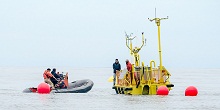Sarah Bedolfe
The first commercial wave energy project in the US will test the use of vertical, piston-like buoys for generating renewable energy.
Focusing on science, technology, engineering, and math (STEM), as they pertain to the ocean.
Last month, the US Federal Energy Regulatory Commission approved the country’s first commercial wave energy project off of the coast of Reedsport, Oregon. The 35-year license allows Ocean Power Technologies Inc. to build up to ten 140-foot buoys, which will generate 1.5 megawatts of power – enough to power 1,000 homes. The first buoy is expected to be deployed in October. OTP has other domestic and international projects.
This newly approved OPT facility will be relatively small but is expected to be a key feasibility test of such technology, and the potential for expansion. Since wave energy is a very new industry, there is still a lot of room for research and innovation. While fields such as wind energy are dominated by a single model, the technology used in wave energy is diverse, to take advantage of various locations and wave conditions, with designs varying in size, shape, and positioning (above or below the water’s surface, or on the seafloor).

Wave energy devices take many forms, such as Pelamis P2 off the coast of Scotland, which lays across the water's surface. Photo by Scottish Government via Flickr, Creative Commons License.
The new OPT wave energy-harnessing buoy is a 140-foot long structure that floats vertically in the water. It is moored to the seafloor but can move freely up and down with passing waves. A float about 30 feet high and 40 feet wide can be seen above the surface and will have navigational aids for ships. It’s installed in water 100-150 feet (30-50meters) deep. The structure is similar to a piston; the vertical motion of passing waves causes the long tube to move within its shaft, and “a sophisticated power take-off,” drives an electrical generator, according the company’s website. The electricity is transferred to shore via a cable.
This system is unique because it is set up to anticipate future conditions. Sensors called wave riders located around the buoy relay data, and the buoy can adjust for it. Its moors are built to withstand a 100-year storm, but if dangerously large waves come through, the system can shut down before they arrive, and then resume working once conditions are calm again.
Wave power is a fairly predictable and common source of renewable energy, and advocates suggest that this system is ideal because it doesn’t generate waste or emissions, or cause noise pollution. It also has little impact on the seabed and is not an eyesore – in fact they would be hardly visible from shore. Some groups are concerned with impacts on wildlife and fisheries.
“Our greatest concern is that they don’t do what they did with dams — put a lot of them in the ocean and then just stand back and see what happens,” said John Holloway, the secretary of Oregon Anglers, a political action committee for recreational fishing. “We’re advocating a go-slow approach.”
Studies on impacts are ongoing.
Meanwhile, the state of Oregon is completing a project to map coastal regions and plan future use, including resolution of potential conflicts between fishing, wave energy development, and other activities.
While the potential of this technology will be tested by OPT, other new possibilities are being studied by Ocean Sentinel, a test facility also located in Oregon. Ocean Sentinel will monitor wave energy, wind speed, ocean currents and other factors.
Further investment in research and testing such as this could lead to a greatly expanded wave energy industry, that could one day supply much of the world’s power.

Ocean Sentinel will measure ocean conditions in order to test wave energy technology. Photo by Pat Kight via Flickr, Creative Commons License.







